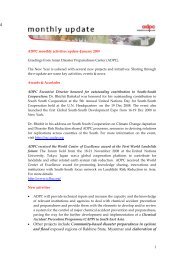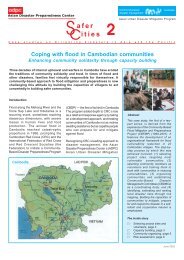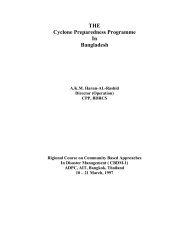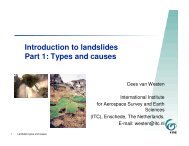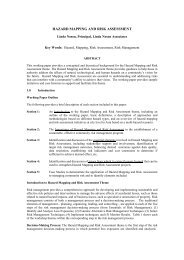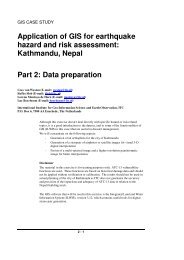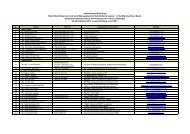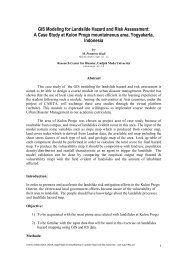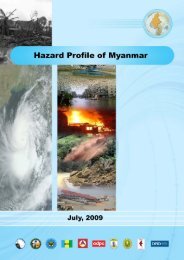community-based disaster risk management and the media media kit
community-based disaster risk management and the media media kit
community-based disaster risk management and the media media kit
Create successful ePaper yourself
Turn your PDF publications into a flip-book with our unique Google optimized e-Paper software.
120<br />
MEDIA KIT<br />
fl oods have occurred over <strong>the</strong> past 35 years. The area most affected<br />
(central <strong>and</strong> sou<strong>the</strong>rn regions) accounts for <strong>the</strong> zone of greatest<br />
economic activity in <strong>the</strong> country, where 63% of <strong>the</strong> country’s population<br />
live. Typhoons that enter <strong>the</strong> country from Vietnam can compound <strong>the</strong><br />
rainfall pattern <strong>and</strong> cause additional fl ooding. An issue of concern for<br />
<strong>the</strong> future is <strong>the</strong> siltation in <strong>the</strong> lower Mekong River basin.<br />
Drought affects about 20% of <strong>the</strong> country’s population, adversely<br />
affecting agricultural production. The areas most prone to drought<br />
are <strong>the</strong> western provinces <strong>and</strong> some of <strong>the</strong> higher elevations of <strong>the</strong><br />
sou<strong>the</strong>rn provinces.<br />
O<strong>the</strong>r potentially disastrous events include l<strong>and</strong>slides, fi re (both urban<br />
<strong>and</strong> forest fi re), agricultural pests <strong>and</strong> epidemics. An analysis of<br />
<strong>disaster</strong> impacts on urbanizing areas show that fi res cause <strong>the</strong> greatest<br />
loss of life <strong>and</strong> property. Dense building concentrations, narrow roads,<br />
fl ammable building materials, aging water supply <strong>and</strong> electrical system,<br />
as well as <strong>the</strong> lack of resources to upgrade preparedness <strong>and</strong> response<br />
skills have resulted in a growing <strong>risk</strong> of large scale, multiple structure<br />
fi res.<br />
Vulnerability<br />
Majority of <strong>the</strong> country’s population do not have <strong>the</strong> capacity to cope<br />
with <strong>disaster</strong>s due to poverty. Most inhabit <strong>the</strong> fl oodplains, making <strong>the</strong>m<br />
vulnerable to <strong>the</strong> annual fl ooding. Its high population growth rate puts<br />
additional strain on environmental conditions. Diffi culties in access <strong>and</strong><br />
communication are a major constraint in <strong>the</strong> country’s development<br />
<strong>and</strong> in <strong>the</strong> response to <strong>disaster</strong>s particularly. Only a limited part of <strong>the</strong><br />
country can be reached by “all wea<strong>the</strong>r” roads, <strong>and</strong> large parts become<br />
inaccessible in times of <strong>disaster</strong>.<br />
Recent Impacts<br />
Floods in 2000 brought loss to more than 42,000 hectares of agriculture<br />
crops <strong>and</strong> damaged more than 200 irrigation units, <strong>and</strong> loss of 15 lives.<br />
Parallel to <strong>the</strong>se, many regions faced severe drought which caused<br />
shortage of drinking water, water for consumption <strong>and</strong> for agriculture<br />
<strong>and</strong> animal raising.<br />
Flash fl oods <strong>and</strong> l<strong>and</strong>slides occurred in Houaphanh, Luang Prabang<br />
<strong>and</strong> Vientiane provinces which were never seen before in <strong>the</strong> country.



